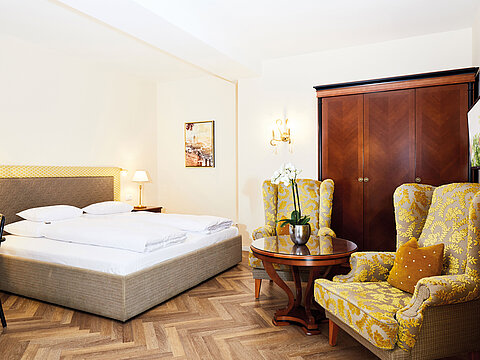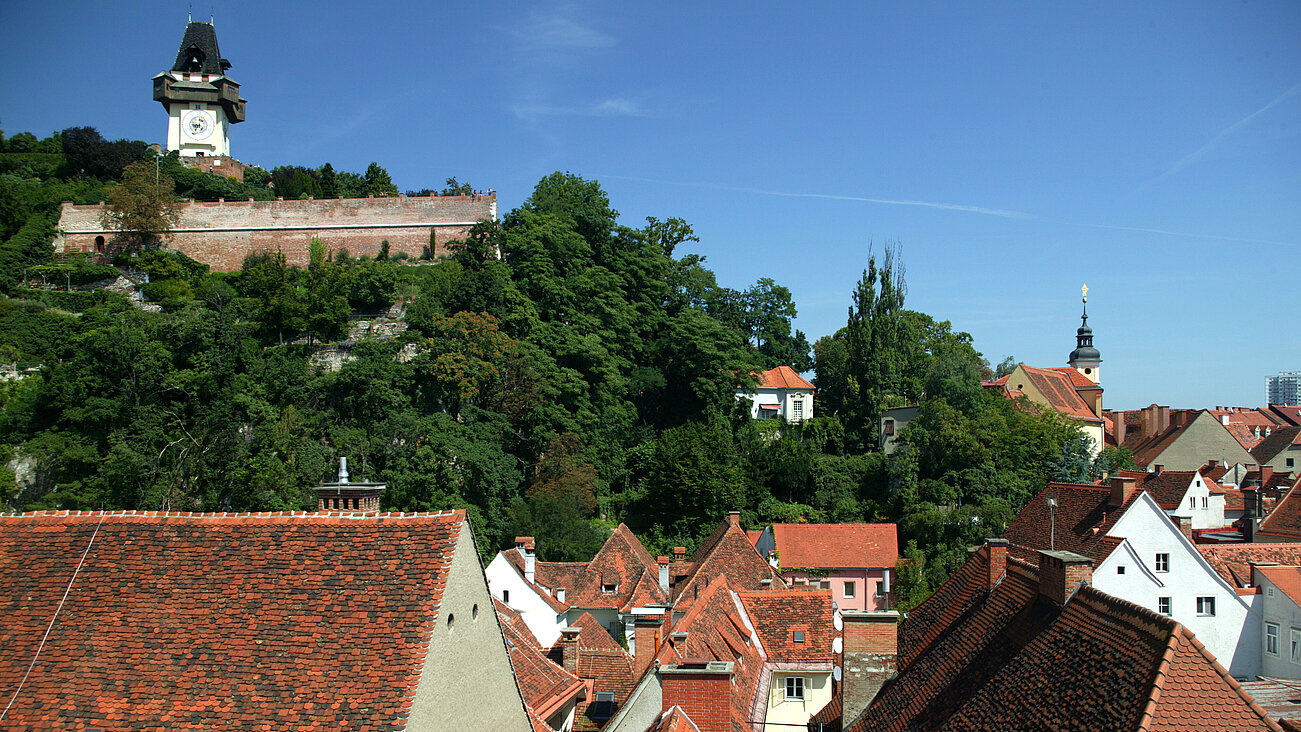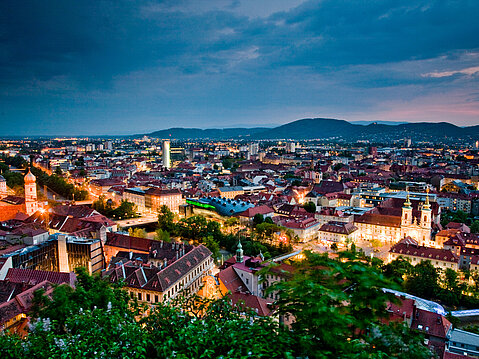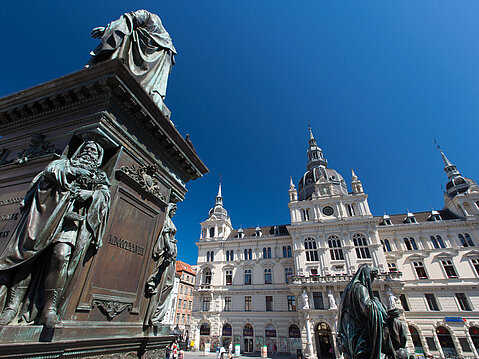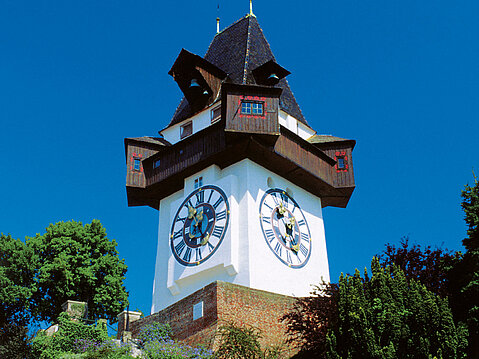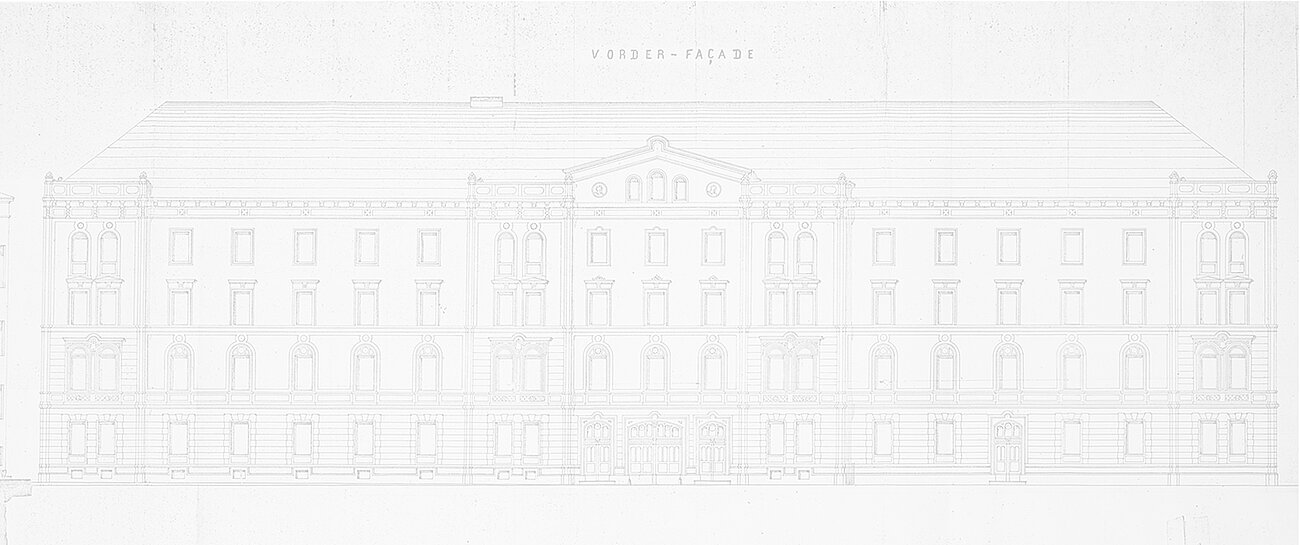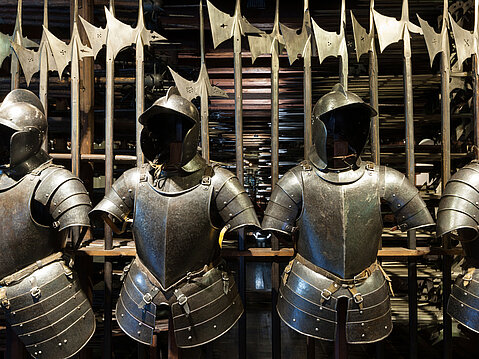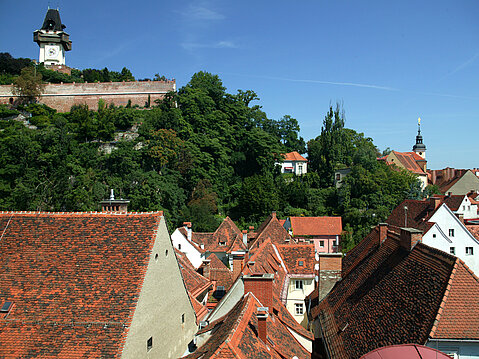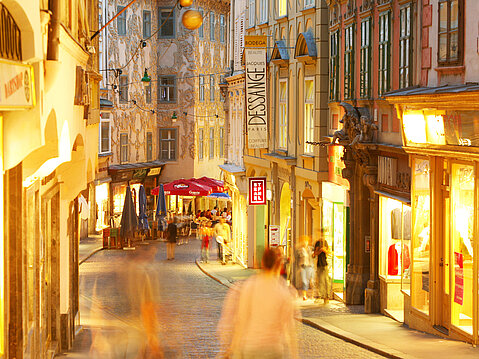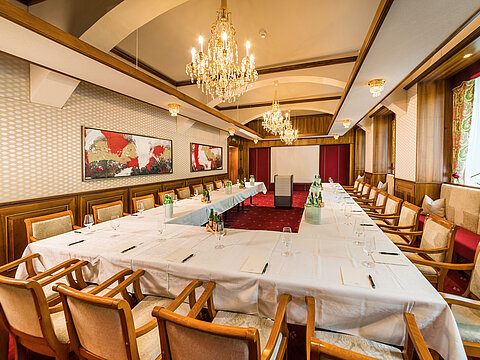At 474 meters, Graz's Schlossberg hill is one of the city's absolute centerpieces. This landmark is located on the Mur River and towers about 123 meters above Graz's main square. The clock tower, the symbol of the city of Graz, is also located directly on the Schlossberg hill.
The Graz Schlossberg is a historic hill in the middle of the city that offers a rich history and breathtaking views. At the top of the Schlossberg, you will find the impressive clock tower, which dominates the cityscape, as well as the imposing casemates, the former defensive structures. Today, the casemates are used as an open-air stage on the Schlossberg. This historic site invites visitors to explore the past as they stroll through the corridors of the casemates or enjoy an incomparable view of Graz from the viewing platforms.
The Graz Clock Tower is an iconic landmark of the city of Graz. This impressive tower was built in the 13th century and rises majestically on the Schlossberg, a hill in the middle of the city. The city landmark, which can be seen from afar, is around 28 meters high and is located around 425 meters above sea level. The tower still has a total of three bells: the hour bell, the fire bell and the arm sinner's bell, which was rung at executions in earlier times.
The clock tower is famous for its unusual clock, in which the hour and minute hands are reversed - a rarity in the art of clockmaking. This unique detail has given the tower its name. The clock tower also offers a breathtaking panoramic view of Graz and the surrounding countryside. Visitors can climb the steep stairs and explore the history of the tower in a small museum. The Graz Clock Tower is a symbol of the city and a must-see for every visitor.
The Schlossbergbahn in Graz is a historic funicular that has been transporting visitors up the Schlossberg in Graz for over 120 years. The funicular not only offers a comfortable way to tackle the steep ascent to the Schlossberg, but also a breathtaking view of the city of Graz and its surroundings. The charming, nostalgic carriages run regularly from the bottom station to the top station, allowing passengers to reach the Schlossberg plateau, where they can explore historic sights such as the clock tower and the casemates.
The Schlossbergbahn is not just a means of transportation, but also a piece of Graz's history and a popular tourist destination. The popular Schlossbergbahn in Graz was redesigned in 2004. The two carriages were fitted with glass roofs, giving passengers a breathtaking panoramic view of the historic old town during the ride.
City of Graz - Historic Center
Not only tourists, but also locals find the flair and ambience of the old town particularly appealing. Especially on warm summer evenings, you feel like you are in a Mediterranean city. Strolling through the historic part of the city is an excellent way to discover the city's culinary delights. Here you will find everything from simple but traditional sausage stands to modern gourmet restaurants. And in winter, Graz's old town is best known for its Advent and Christmas markets.
The historic city center reflects a centuries-old connection between artistic and architectural movements that originated in the German and Mediterranean regions and even in the Balkans. The appearance of the city with its many sights and Eggenberg Palace clearly shows their mutual historical and cultural development and is an exceptional example of the harmonious integration of the architectural styles of successive eras.
The old town of Graz: creative and enjoyable
Simply stroll through the streets, be open to discoveries, seek out small design stores, visit unusual and unique cafés and use a sculpture park as a photo stage - all this and much more is possible in the cultural city of Graz.
If you want to get an overview of the city of Graz and get your bearings, the best place to do this is from the Schlossberg, Graz's popular viewing hill. On a tour with a city guide, you can not only see the facades of the beautiful houses or the roofs of the old town from above, but also discover the hidden courtyards. 260 steps or the Schlossbergbahn cable car lead from the old town directly up to Graz's popular panoramic hill. The clock tower, which is the city's landmark, watches over the beautiful and idyllic city from there.
Graz Cathedral, one of the city's most important buildings in terms of art and cultural history and one of the most famous sights in Graz, is enthroned between Bürgergasse and Burggasse. This impressive Gothic building was erected in the 15th century and is characterized by its imposing architecture and rich history. Inside the cathedral you will find beautiful Gothic and Baroque works of art as well as valuable altars and frescoes. The impressive organ and the magnificent pulpit are further highlights that you should see during your cultural vacation in Graz. Graz Cathedral serves as an important cultural and religious site and attracts visitors from all over the world. Together with the neighboring mausoleum, the Schauspielhaus and the castle, the late Gothic sacred building forms the "Graz City Crown" at the foot of the Schlossberg.
The beating heart of Graz
The central axis of the old town, Herrengasse, is one kilometer long and stretches from Jakominiplatz to Hauptplatz. Young and old meet here to store and stroll, and travelers will find a central point of contact with the Graz Tourist Information Office.
Admire the magnificent arcades in the courtyard of the Landhaus, the adjacent Landeszeughaus, the painted house and the baroque parish church. The most striking features here are Graz Town Hall, built at the end of the 19th century, and the fountain monument in the middle of the square.
Graz's main square is one of the most impressive sights in the Styrian capital and forms the lively heart of Graz. Surrounded by magnificent historical facades, the square is dominated by the imposing Graz City Hall, which is one of the architectural highlights of the old town. Another landmark is the ornate fountain monument, which symbolizes the four most important Styrian rivers. Centrally located, the main square connects the charming narrow streets of the old town with the modern city center. Throughout the year, it becomes the stage for numerous events, such as the Christmas market, the Graz Jazz Summer Festival or the popular farmers' market with regional specialties. Whether as a cultural center or tourist attraction - the main square inspires with history, atmosphere and urban flair.
The Opera House in Graz is one of Austria's most impressive theaters and is located right on the edge of the old town. The neo-baroque opera house was built around 1900 and impresses with its magnificent architecture, an imposing auditorium, and a diverse program of opera, operetta, musicals, and ballet. International productions, modern stagings, and classical masterpieces make the Graz Opera House a cultural landmark of the city. A visit is worthwhile not only for music lovers but also for architecture enthusiasts—for example, on a guided tour of the magnificent building.
The Schauspielhaus in Graz is one of the most renowned theaters in the German-speaking world and is located just a few steps away from the cathedral, in the heart of the historic old town. The classicist theater building inspires audiences with a diverse range of classic plays, contemporary pieces, and innovative productions. Visitors can not only enjoy great theater, but also discover the impressive architecture of the building. The Schauspielhaus is a cultural highlight for anyone who wants to experience Graz in the evening.
The Stadtpark is a green oasis right next to Graz's old town. With its extensive lawns, old trees, and stylish sculptures, it is a wonderful place to relax. In addition to recreation, the city park also offers cultural inspiration: exhibitions, readings, and events take place regularly in the artists' pavilion and the Forum Stadtpark. The city park is worth a visit at any time of year—whether for a walk, a picnic, or an inspiring encounter with Graz's creative scene.
Franciscan Quarter & Franciscan Church
The historic Franciscan Quarter with its imposing Franciscan Church is a real gem in the heart of the old town. The 14th-century Gothic church impresses with its Baroque high altar, valuable works of art, and a quiet cloister that invites visitors to linger. The modern glass façade is particularly fascinating, forming an exciting contrast to the old building structure. Away from the busy shopping streets, the Franciscan Quarter offers charming alleys, small boutiques, and cozy cafés—an insider tip for anyone who wants to experience authentic Graz.
The Landeszeughaus is considered to be the largest preserved historical armory in the world. With around 32,000 objects, it is a testimony to a conflict-ridden time and a sensitive heritage and museum on the history of Styria. The collection of the Landeszeughaus includes armor and weapons from the 15th to the 18th century and is thus an incomparable monument to a bygone era.
Affectionately known as the "friendly alien" because of its striking architecture, the Kunsthaus Graz on the left bank of the Mur stands out from the sea of red roofs in the old town. The Graz Kunsthaus was given this special nickname because of its alien-looking façade. The Kunsthaus houses an impressive collection of contemporary artworks and regularly presents captivating exhibitions of national and international artists. It is a place of creative innovation and cultural encounters and attracts art lovers and the curious in equal measure. The Kunsthaus Graz is a must for anyone who wants to explore the world of modern art.
You can't miss it, the Graz Murinsel floating in the middle of the river, which has become a popular attraction since its installation in the Capital of Culture year 2003. Accessible from both banks via footbridges, it houses a café and a store with regional products and also functions as a venue for a wide variety of cultural events. At night, the colorful lighting makes the Murinsel an eye-catcher and one of the most popular sights in Graz.
Together with the old town of Graz, Eggenberg Palace is also a UNESCO World Heritage Site. Eggenberg Palace, also known as the "Versailles of Styria", is an impressive baroque palace in Graz. This magnificent property on the outskirts of Graz was built in the 17th century for the Count of Eggenberg and is a masterpiece of Baroque architecture. The palace is surrounded by an extensive park adorned with magnificent gardens, water features and sculptures. The interior of Eggenberg Palace is just as impressive as the exterior. The Giants' Hall, also known as the Planets' Room, is a highlight, depicting the seven ancient planets. The Picture Gallery houses an impressive collection of works of art. One of the castle's outstanding features is its impressive planet garden. Together with the impressive Old Gallery, the Archaeology Museum and the Coin Cabinet, the site is also home to the most valuable objects in Austrian cultural history.
The famous Landhaushof in Graz was built by Domenico dell' Aglio and is a historic and still culturally significant site. Built in the 16th century, the building originally served as the provincial administration and today houses the Landeszeughaus, an impressive museum with one of the largest collections of weapons in Europe. The country house courtyard itself is an impressive example of Renaissance architecture and is surrounded by an inner courtyard with a beautiful arcade. It has a total of 3 floors and the fountain arbor, providing a wonderful backdrop for various concerts, film screenings and recitals. In this respect, the country house is internationally renowned.
The Graz Glockenspiel was created at the beginning of the 19th century as a gift from the former spirits manufacturer Gottfried Simon Maurer. It is located directly in the city center of Graz, at Glockenspielplatz number 4, and attracts visitors from all over the world. The carillon consists of 24 bells and two figures, a girl and a boy, who bring the carillon to life on the hour. Every day, the wooden couple in traditional costume rotates a total of three times to different melodies, at 11.00 am, 3.00 pm and 6.00 pm. Different songs and compositions are played each time, so it pays to visit Graz city center and the Glockenspiel at different times of the year.
The mausoleum in Graz, also known as the "Habsburg Mausoleum", is a magnificent resting place for members of the Habsburg dynasty, which once ruled the Austrian Empire. The Graz Mausoleum houses the tomb of Emperor Ferdinand II and has been one of the most important buildings in Austria ever since. The mausoleum was built between 1614 and 1638 according to the designs of Giovanni de Pomis. The dome of the mausoleum, which is decorated with elaborate frescoes, is particularly impressive. The mausoleum is not only a place of historical significance, but also an impressive example of Baroque art and architecture. Together with Graz Cathedral and the castle, the mausoleum forms the so-called "city crown" in Graz.
How to get to the city center
The old town forms the center of Graz. It stands to reason that (almost) all roads lead there. The streetcar lines run through Herrengasse from Hauptplatz to Jakominiplatz and vice versa. Jakominiplatz is the public transport hub, so to speak. In addition to public transport, the old town of Graz can also be explored on foot or by bike. Almost all of Graz's main cycle paths run through or past the city center. There are also numerous parking garages and parking spaces near the old town. From the Parkhotel Graz, it is only a 10-minute walk to Jakominiplatz or the city center.
Roughly speaking, the old town can be reached from four directions:
- Jakominiplatz (south)
- Murkai (north)
- Lendplatz (west)
- Stadtpark (east)
